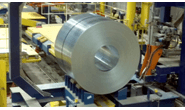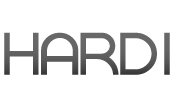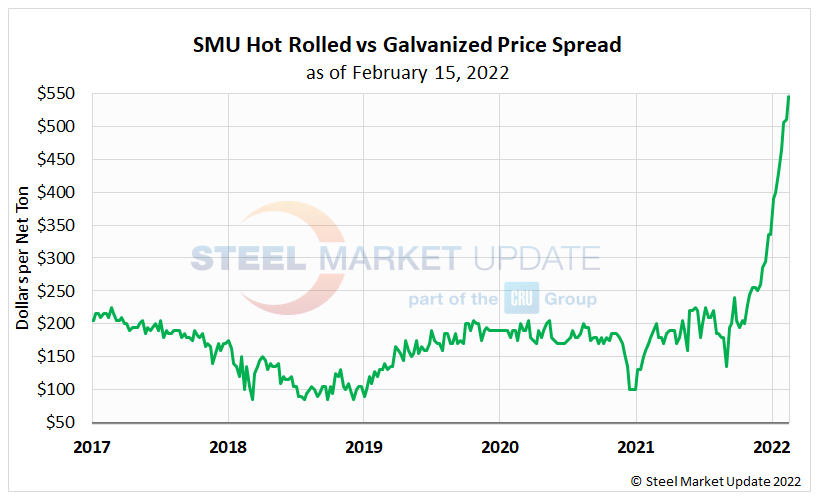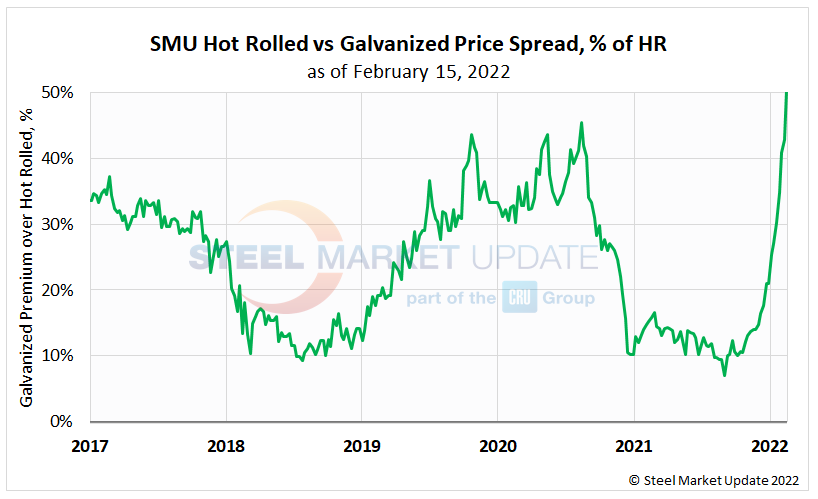Steel Products

SMU Deep Dive: HRC-Galv Spreads Continue to Balloon
Written by Michael Cowden
February 20, 2022
Prices for steel sheet have fallen across the board since September of last year. But the pace of declines for hot-rolled coil has been much faster than for galvanized products.
The result: Spreads between HRC prices and galv base prices – which have been at record levels since late last year – continue to widen. Check out the charts below:
{loadposition reserved_message}
The current HRC-galv base spread is $545 per ton ($27.25 per cwt), or a 50% premium over hot rolled.
The dollar amount of that spread has reached (or stayed at) a new record high each of the last 12 weeks. The 50% premium last week marked another new record, surpassing the previous record of 49% in October 2016.
The current spread between HRC and galv is higher than the price of HRC itself in past years. It is also more than double an average of approximately $150-200 per ton over the last five years. And some industry veterans would say that even that ~$175-per-ton figure is inflated compared to past norms.
What is driving such historic spreads: industry consolidation, new pricing structures or something else entirely? And are these spreads sustainable? Recent history would suggest not. But the issue is not specific to HRC and galv.
We’ve seen similarly unprecedented spreads between HRC and plate. And there is little overlap between plate markets (think energy, infrastructure and heavy equipment) and galv markets, which are more exposed to consumer or residential construction markets such as automotive, appliance and metal roofing.
The root cause of the spread between HRC and plate is easy enough to explain. Sheet mills have been lowering prices quickly even if those price decreases, as is typically the case in steel, are never officially announced. Plate mills in contrast have been officially holding the line on prices even as HRC prices have dropped like a rock.
Another difference: You can hedge the spread between HRC and galv on the CME. No such contract exists for the spread between HRC and plate, perhaps because the plate market is so much smaller.
The CME’s HRC-galv spread contract has struggled with low liquidity. That might have been because the spread was typically within a narrow and predictable bandwidth.
With that no longer the case – and the potential for volatility high – it will be interesting to see whether more volume comes into that contract in the days and weeks ahead.
By Michael Cowden, Michael@SteelMarketUpdate.com

Michael Cowden
Read more from Michael CowdenLatest in Steel Products
CRU: Excessive global supply could hit rebar mill investments in US
Following the onset of the war in Ukraine in March 2022, concerns about import availability and expectations of rising demand from President Biden’s Infrastructure Bill pushed US rebar prices to record highs. In response, a flurry of new mills and capacity expansions were announced to meet the rise in demand from growth in the construction […]

Steel buyer spirits tempered by soft spot market conditions
Steel sheet buyers report feeling bogged down by the ongoing stresses of stagnant demand, news fatigue, tariff negotiations or implementation timelines, and persistent macroeconomic uncertainty.

CRU: US stainless prices to rise on expanded S232 tariffs
Stainless prices in the US market will rise, following price increases by major US producers. Our base case scenario incorporates higher US prices in the near term, despite the initial negative reaction by the market. US stainless prices will go up in 2025 H2 and will stay elevated in 2026 as tariffs on stainless […]

Galvanized steel demand unsteady amid lingering buyer fatigue: HARDI
Uneven demand for galvanized steel in June reflects a market that remains mired in uncertainty, according to industry sources.

OCTG industry salutes Customs for catching trade crooks
The US OCTG Manufacturers Association is commending US Customs for intercepting another Thai company's attempt to illegally transship Chinese oil pipe to the US.


